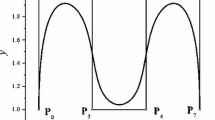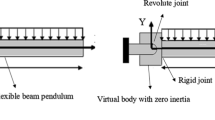Abstract
In the finite element absolute nodal coordinate formulation (ANCF), the elimination of the relative translations and rotations at a point does not necessarily define a fully clamped joint, particularly in the case of fully parameterized ANCF finite elements that allow for the deformation of the cross section. In this investigation, the formulations and results of two different sets of clamped end conditions that define two different joints are compared. The first joint, called the partially clamped joint, eliminates only the translations and rotations at a point on the cross section. The second joint, called the fully clamped joint, eliminates all the translation, rotation and deformation degrees of freedom at a point on the cross section. The kinematic equations that define the partially and fully clamped joints are developed, and the dynamic equations used in the comparative numerical study presented in this paper are shown. As discussed in this investigation, the fully clamped joint does not allow for the deformation of the cross section at the joint node since the gradient vectors remain orthogonal unit vectors. The partially clamped joint, on the other hand, allows for the deformation of the cross section. Nanson’s formula is used as a measure of the deformation of the cross section in the case of the partially clamped joint. A very flexible pendulum that has a rigid body attached to its free end is used to compare the results of the partially and fully clamped joints. The numerical results obtained using this very flexible pendulum example show that, while the type of joint (partially or fully clamped) does not significantly affect the gross reference motion of the system, there are fundamental differences between the two joints since the partially clamped joint allows for the cross section deformations at the joint node.
Similar content being viewed by others
References
Bonet, J., Wood, R.D.: Nonlinear Continuum Mechanics for Finite Element Analysis. Cambridge University Press, Cambridge (1997)
Garcia-Vallejo, D., Mayo, J., Escalona, J.L.: Three-dimensional formulation of rigid-flexible multibody systems with flexible beam elements. Multibody Syst. Dyn. 20(1), 1–28 (2008)
Garcia-Vallejo, D., Mayo, J., Escalona, J.L., Dominguez, J.: Modelling three-dimensional rigid-flexible multibody systems by using absolute coordinates. In: 12th IFToMM World Congress, Besancon, June 18–21, 2007
Gerstmayr, J., Shabana, A.A.: Analysis of Thin Beams and Cables Using the Absolute Nodal Coordinate Formulation. Technical Report MBS05-3-UIC (2005)
Kerkkanen, K.S., Garcia-Vallejo, D., Mikkola, A.M.: Modeling of belt-drives using a large deformation finite element formulation. Nonlinear Dyn. 43, 239–256 (2006)
Maqueda, L.G., Shabana, A.A.: Poisson modes and general nonlinear constitutive models in the large displacement analysis of beams. Multibody Syst. Dyn. 18, 375–396 (2007)
Mikkola, A.M., Matikainen, M.K.: Development of elastic forces for the large deformation plate element based on the absolute nodal coordinate formulation. ASME J. Comput. Nonlinear Dyn. 1, 103–108 (2006)
Ogden, R.W.: Non-Linear Elastic Deformations. Ellis Horwood, Chichester (1984)
Schwab, A.L., Meijaard, J.P.: Comparison of three-dimensional flexible beam elements for dynamic analysis: finite element method and absolute nodal coordinate formulation. In: Proceedings of ASME International Design Engineering Technical Conferences and Computer Information in Engineering Conference (DETC2005/MSNDC-85104), Long Beach, CA, United States, 2005
Shabana, A.A.: Computational Dynamics, 2nd edn. Wiley, New York (2001)
Shabana, A.A.: Dynamics of Multibody Systems, 3rd edn. Cambridge University Press, Cambridge (2005)
Shabana, A.A.: Computational Continuum Mechanics. Cambridge University Press, Cambridge (2008)
Shabana, A.A., Yakoub, R.Y.: Three-dimensional absolute nodal coordinate formulation for beam elements: theory. ASME J. Mech. Des. 123(4), 606–613 (2001)
Sopanen, J.T., Mikkola, A.K.: Description of elastic forces in absolute nodal coordinate formulation. Nonlinear Dyn. 34, 53–74 (2003)
Spencer, A.J.M.: Continuum Mechanics. Longman, Harlow (1980)
Sugiyama, H., Escalona, J.L., Shabana, A.A.: Formulation of three-dimensional joint constraint using the absolute nodal coordinates. Nonlinear Dyn. 31, 167–195 (2003)
Weed, D., Maqueda, L.G., Brown, M., Shabana, A.A.: A multibody/finite element nonlinear formulation of a two-ligament knee joint. In: Proceedings of the 2008 ASME International Mechanical Engineering Congress and Exhibition, Boston, MA, October 31–November 6, 2008
Yakoub, R.Y., Shabana, A.A.: Use of Cholesky coordinates and the absolute nodal coordinate formulation in the computer simulation of flexible multibody systems. Nonlinear Dyn. 20, 267–282 (1999)
Yakoub, R.Y., Shabana, A.A.: Three-dimensional absolute nodal coordinate formulation for beam elements: implementation and applications. ASME J. Mech. Des. 123(4), 614–621 (2001)
Yoo, W.S., Lee, J.H., Park, S.J., Sohn, J.H., Pogorelov, D., Dimitrochenko, O.: Large deflection analysis of a thin plate: computer simulation and experiment. Multibody Syst. Dyn. 11(2), 185–208 (2004)
Author information
Authors and Affiliations
Corresponding author
Rights and permissions
About this article
Cite this article
Hussein, B.A., Weed, D. & Shabana, A.A. Clamped end conditions and cross section deformation in the finite element absolute nodal coordinate formulation. Multibody Syst Dyn 21, 375–393 (2009). https://doi.org/10.1007/s11044-009-9146-6
Received:
Accepted:
Published:
Issue Date:
DOI: https://doi.org/10.1007/s11044-009-9146-6




